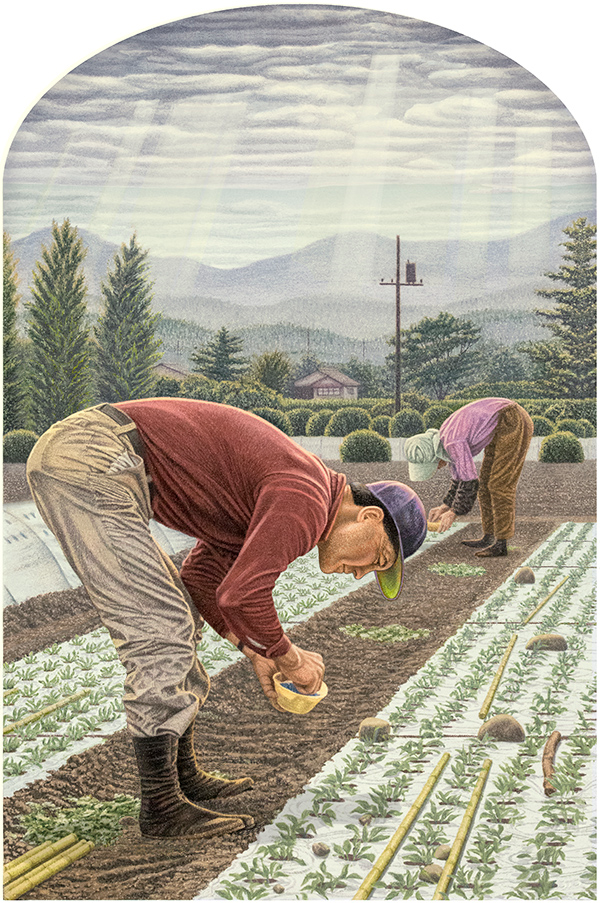
Detail of Farmers
FARMERS: the artist's view
SKU: 4
Originally, the top of the picture was flat with a larger amount of cloudy sky. But too much sky made connecting the top and bottom of the composition awkward. So I lowered the top of the picture with the arch, whose sides move downward toward the main part of the picture. Greater connection was still needed, so I added the shafts of sunlight. The arch and the sunbeams not only altered the composition, but also affected the psychological impact of the picture. But analyzing the composition of a picture is much more objective* than describing the psychology of a picture. So, not wanting to undermine your emotional response to the picture with my words, I will leave that subjective** part to you and focus on the composition.
The top half of the picture is carefully woven together, strongly impacted by the arch. The curves of the farmers' backs echo the arch–while the soft shafts of sunlight reach down to tighten the considerable distance between the arch and the couple. The evergreens and electric pole reach up, pulling the lower part of the composition back up toward the sky. And the undulating silhouette of the couple's backs is intentionally complemented by the undulating top-ridge of the mountains. The act of adding the ridge felt similar to matching a line of harmony to a line of melody in music–an example of the correlation between art and music.
The downward direction of the beams of light is countered from below by the upward angle of the rows of plants. The plant rows draw your eye up toward the farmer's face–and up the right side toward his wife. But the light beams and the plant rows do not converge on the same spot. The shafts of light angle more toward the left side of the picture and down the legs and arms of the farmer–while the rows of plants point up the right side through the legs of the wife to the tall pine tree on the right. So the light beams and the plant rows are offset from each other, giving greater complexity to the composition.
As in all my giclée prints, this picture goes from near to far–from the plant rows and bamboo poles at the very bottom of the picture, where you the viewer stand, to the hazy mountains in the far distance.
The bottom half of the picture is much more dynamic than the top half–a challenging combination to unify. The division between the two halves is marked by the white, plastic, vegetable canopy that runs horizontally across the picture in the near distance. There are other horizontals in this vertical picture–particularly the layers of clouds which counteract the downward direction of the sunbeams. Near the end of the creative process, the thin, horizontal gaps between the plastic sheets (on the bottom half) seemed weak. So I accentuated some and added others. They are just obvious enough to moderate the upward rush of the rows of plants.
A Japanese color scheme puts cranberry, purple and pinkish-lavender together–three warm colors that are close to each other on the color wheel–something you will see in kimono colors but is generally avoided in western dress.
The soft textures of the original pastel-painting remain despite many adjustments to this picture. Varied textures are an important feature of all my prints, so I took care to maintain them as much as possible through all the changes.
The most prominent element of the composition is yet to be mentioned: the solid pose of the farmer strongly anchored on his feet–a stable, upside-down triangle spreading upward. He is immovable, with a self-contained patience and perseverance, with restrained power and resolve–as is his wife. He and she are tied together visually and in their mutual commitment to the task. So you can see that composition affects the psychological, which I said I wouldn't stray into…
The farmer's stooped pose, downward gaze, bent arm, and bill of his cap point the viewer's eyes back toward the lower-right corner. From there you are guided upward again by the bamboo poles–aided by the swirl of the yellow bowl, four carefully placed stones, and the wife's feet and hands. These are a few of the various, small shapes that float throughout the composition. Even the angle of the farmer's belt-loop slants upward as his body stoops down–an interesting juxtaposition that helps connect the farmer to the upper part of the picture. This, of course, was not an intentional choice, but is just a feature of the original photo. It is one of the many givens in this picture that subconsciously influenced my intentional choices–an example of how one part impacts and plays off another–often intuitively or unconsciously.

Title: Farmers Size: 23.6 x 15.6" / 60 x 39.7 cm $177 Edition: 299 (Signed & Numbered/Unframed) Date: 2025
* objective: based on reality, or verifiable observations, facts, information, data from outside one's self
** subjective: based on personal feelings, perspectives, thoughts, experiences